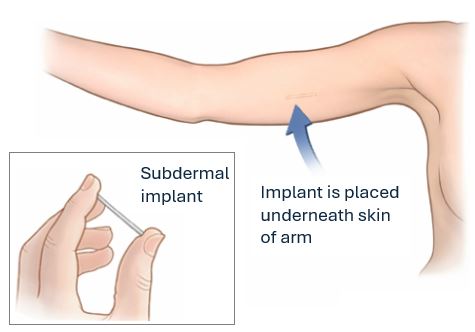Insertion or removal of contraceptive implant
Nexplanon is a subcutaneous implant placed under the skin on the inside of the upper arm to prevent pregnancy. The implant is a small, 4 cm long, soft, flexible plastic rod that contains corpus luteum hormone.

From the hormonal implant, a small amount of corpus luteum hormone is constantly released into your bloodstream, which prevents the release of the egg from the ovaries and causes changes in the composition of the cervical mucus, making it difficult for sperm cells to enter the uterus. Nexplanon protects you against pregnancy for three years.
Nexplanon is suitable for women
- who want long-term pregnancy prevention
- who, for some reason, cannot or does not want to use birth control pills
- who are breastfeeding
- preferably suitable for women with profuse menstruation
The contraceptive effect of Nexplanon appears immediately after insertion. Nexplanon is inserted and removed under aseptic conditions under local anaesthesia. Nexplanon is placed under the skin on the inside of the upper arm of your non-dominant hand (the hand you don't write with). The best time to insert Nexplanon is days 1-5 of your period, but it doesn't have to be the rule. After installation, the implant can be palpated under the skin. After the procedure, you will be given a gauze pad with a sterile pressure bandage to reduce bruising. You can remove the pressure bandage after 24 hours and the small patch at the site after three days.
Do not install Nexplanon
- if you are allergic to the luteinizing hormone in the implant;
- if you have thrombosis;
- if you have or have had jaundice;
- if you have (had) or are suspected of having breast or genital cancer;
- if you have unexplained vaginal bleeding.
It is necessary to consult a doctor before installing Nexplanon.
Possible complications:
- Menstrual bleeding can change - stop, become irregular, infrequent, frequent, prolonged or, in rare cases, heavy. The bleeding you experience in the first three months often predicts the type of bleeding you will encounter later. If changes in the menstrual cycle interfere with your daily life, it is possible to remove Nexplanon;
- When Nexplanon is inserted or removed, bruising, pain, swelling, or itching may occur, and in rare cases, inflammation, scar formation, or abscess formation at the implant site;
- The implant can move from the original place of installation. In such cases, positioning the implant may be more complex, and removal may require a larger incision;
- Fluid-filled cysts or cysts can form in the ovaries. They usually go away on their own. Sometimes, it causes mild abdominal pain. Only rarely can they lead to more severe disorders;
- Thrombosis. This is the formation of a blood clot in a blood vessel. With Nexplanon, the risk of thrombosis is lower than during pregnancy and when using combined birth control pills that contain estrogen in addition to the corpus luteum hormone. While you notice possible signs of thrombosis, such as severe pain or swelling in one of your legs, chest pains, shortness of breath, coughing up blood;
- Pregnancy. Pregnancy occurs very rarely. If you become pregnant and want to keep the pregnancy, it is recommended that Nexplanon be removed;
In the case of Nexplanon, adhering to the use time is necessary
Nexplanon must be removed or replaced no later than three years after installation. Fertility is restored after the implant is removed. You can get pregnant during the next menstrual cycle.
The cost of the procedure includes the cost of consulting a doctor.
